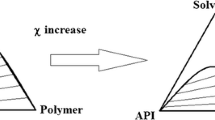Abstract
Purpose
To develop a strategy to control benzene, an ICH Q3C Class 1 impurity that may be present in spray solvents at ppm concentration, in amorphous polymer-stabilized spray-dried dispersion (SDD) products.
Methods
Risk assessments included determining the probability for benzene concentration in primary spray solvents, the physical properties of volatiles, and the potential enrichment of benzene from solution to solid. Mechanistic understanding of benzene removal was gained through a benzene-spiked fate and tolerance (F&T) study simulating worst-case spray-drying conditions and application of diffusion models for secondary drying.
Results
The mass ratio of spray solution to solid presented the highest risk of benzene enrichment. With slow spray-drying kinetics, benzene was reduced about 700-fold. Under standard secondary-drying conditions to remove residual solvents, residual benzene was further removed. Using diffusion models, the maximum benzene concentration was approximated for SDDs dried to the in-process control (IPC) limit of primary solvents.
Conclusions
Two critical control points were established to eliminate any risk of residual benzene reaching patients: (1) upstream control of benzene in solvents (≤10 ppm) and (2) IPC of residual solvents in polymer-stabilized SDDs.



Similar content being viewed by others
Abbreviations
- %RSD:
-
Percentage of relative standard deviation
- [imp]solids :
-
Impurity concentration in the SDD
- [imp]solvent :
-
Impurity concentration in the primary spray solvent
- API:
-
Active pharmaceutical ingredient
- EP:
-
European pharmacopoeia
- F&T:
-
Fate and tolerance
- FID:
-
Flame ionization detector
- GC:
-
Gas chromatography
- HPMCAS:
-
Hydroxypropylmethyl cellulose (hypromellose) acetate succinate
- ICH:
-
International conference on harmonisation
- IPC:
-
In process control
- JP:
-
Japan pharmacopoeia
- LOQ:
-
Limit of quantification
- NF:
-
National formulary
- ppm:
-
Parts per million
- RER:
-
Relative evaporation rate
- RH:
-
Relative humidity
- RSout :
-
Relative saturation of solvent at the spray-dryer outlet
- SDD:
-
Spray-dried dispersion
- Tcondenser :
-
Condenser temperature
- Tg :
-
Glass-transition temperature
- Tin :
-
Spray-dryer inlet temperature
- Tout :
-
Spray-dryer outlet temperature
- β:
-
Diffusion parameter
- ΔHvap :
-
Heat of vaporization
References
Mooter GVD. The use of amorphous solid dispersions: a formulation strategy to overcome poor solubility and dissolution rate. Drug Discov Today Technol. 2012;9(2):79–85.
Ray R. Addressing solubility challenges: using effective technology & problem-solving for delivery solutions. Drug Dev Deliv. 2012;12(6):26–8.
Dobry DE, Settell DM, Baumann JM, Ray RJ, Graham LJ, Beyerinck RA. A model-based methodology for spray-drying process development. J Pharm Innov. 2009;4:133–42.
Friesen DT, Shanker R, Crew M, Smithey DT, Curatolo WJ, Nightingale JAS. Hyroxypropyl methylcellulose acetate succinate-based spray-dried dispersions: an overview. Mol Pharm. 2008;5(6):1003–19.
Paudel A, Worku Z, Meeus J, Guns S, Mooter GV. Manufacturing of solid dispersions of poorly water soluble drugs by spray drying: formulation and process considerations. Int J Pharm. 2013;453:263–84.
ICH. Impurities: guideline for residue solvents Q3C(R5). ICH; February 2011.
Gomaa H, Waterous J, Wallace J. Environmental control considerations for a modern cumene/phenol complex. IPcom J. 2012;12(6B).
Leblanc J, Schneider R, Strait R. Handbook of methanol, methanol production. IPcom J. 2012;12(5B).
McMichael WJ, Nichols DG. Behavior of a semibatch coal gasification unit. Symp Proc Environ Aspects Fuel Convers Technol. 1981;V:317–32.
Weissermel K, Arpe HJ. Industrial Organic Chemistry. 4th ed. Weinheim: VCH Verlagsgesellschaft GmbH; 2008. p. 355–7.
Wenyu L. Optimization measures and analysis to influence factors on the quality of acetone. Shi hua ji shu. 2011;18(3):51–3.
Hsieh D, Yue H, Nicholson S, Roberts D, Schild R, Gamble J, Lindrud M. The secondary drying and the fate of organic solvents for spray dried dispersion drug product. Pharm Res. doi: 10.1007/s11095-014-1577-y
Gao P. Amorphous pharmaceutical solids: characterization, stabilization, and development of marketable formulations of poorly soluble drugs with improved oral absorption. Mol Pharm. 2008;5(6):903–4.
Karlsson OJ, Stubbs JM, Karlsson LE, Sundberg DC. Estimating diffusion coefficients for small molecules in polymers and polymer solutions. Polymer. 2001;42:4915–23.
ICH. Pharmaceutical development Q8(R2). August 2009.
ICH. Quality risk management Q9. November 2005.
ACKNOWLEDGMENTS AND DISCLOSURES
The authors are greatly thankful for the analytical input from Kristin Ketner (Bend Research); engineering support from Johnny Baumann (Bend Research); and project coordination from Jessica Yankovich (Bend Research).
Author information
Authors and Affiliations
Corresponding author
Rights and permissions
About this article
Cite this article
Yue, H., Nicholson, S.J., Young, J.D. et al. Development of a Control Strategy for Benzene Impurity in HPMCAS-Stabilized Spray-Dried Dispersion Drug Products Using a Science-Based and Risk-Based Approach. Pharm Res 32, 2636–2648 (2015). https://doi.org/10.1007/s11095-015-1649-7
Received:
Accepted:
Published:
Issue Date:
DOI: https://doi.org/10.1007/s11095-015-1649-7




